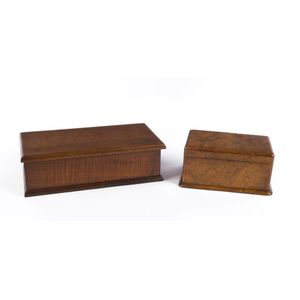Tasmanian Musk and Fiddleback Blackwood Jewellery Boxes
A Tasmanian musk jewellery box together with a fiddleback blackwood box, 19th and early 20th century, (2 items), the musk box 9.5 cm high, 18.5 cm wide, 12 cm deep
You must be a subscriber, and be logged in to view price and dealer details.
Subscribe Now to view actual auction price for this item
When you subscribe, you have the option of setting the currency in which to display prices to $Au, $US, $NZ or Stg.
This item has been sold, and the description, image and price are for reference purposes only.
- Fiddleback - A name given to the pattern of the grain in some timbers, where the lines of the grain are compressed and at the same time wavy. Fiddleback grain is prized as a timber for furniture and musical instruments, and is expensive becasue of its scarcity.
In Australia fiddleback graining is found in blackwood. Other non-native timbers that are sometimes found with a fiddleback grain are mahogany and maple. - Musk Wood - The musk is native to Tasmania, and is found in the rainforests and wetter regions especially along river banks. It grows to a height of between five and fifteen metres, it has a musk scent. A rare timber and therefore mainly used as a veneer in the 19th-century, it is light brown in colour and furniture constructed from it is very expensive.
- Blackwood - One of the best known and most widely used Australian timbers, blackwood (acacia melanoxylon), is a member of the Acacia (wattle) family and grows in eastern Australia from about Adelaide in South Australia, as far north as Cairns in Queensland.
The largest, straightest and tallest trees come from the wet forest and swamps of north-west Tasmania where it is grown commercially.
Blackwood timber colours range across a wide spectrum, from a very pale honey colour through to a dark chocolate with streaks of red tinge.
The hardwood timber has been commonly used in the production of furniture, flooring, and musical instruments in Australia from the late 19th century. However, the straight grain timber is not the most prized or valuable, that honour falls to blackwood with a wavy, fiddleback pattern, which is used both in the solid and as a veneer. Fiddleback was only used on the finest examples of furniture.
This item has been included into following indexes:
- boxes, function - jewellery boxes, wooden 252
- boxes, material or decoration
Visually similar items

A Tasmanian blackwood and musk glove box, together with a spatter work jewel box, late 19th century, largest 6 cm high, 30 cm wide, 11 cm deep
Sold by
in
for
You can display prices in $Au, $US, $NZ or Stg.

Sterling silver cigarette box, Birmingham 1971. Jbc over &S over Ld into a shield
Sold by
in
for
You can display prices in $Au, $US, $NZ or Stg.

A Tasmanian deed box, musk veneered on huon pine carcass, 14 cm high, 33 cm wide, 23 cm deep
Sold by
in
for
You can display prices in $Au, $US, $NZ or Stg.

A mahogany writing box, English, circa 1865, 10 cm high, 36 cm wide 23 cm deep
Sold by
in
for
You can display prices in $Au, $US, $NZ or Stg.
